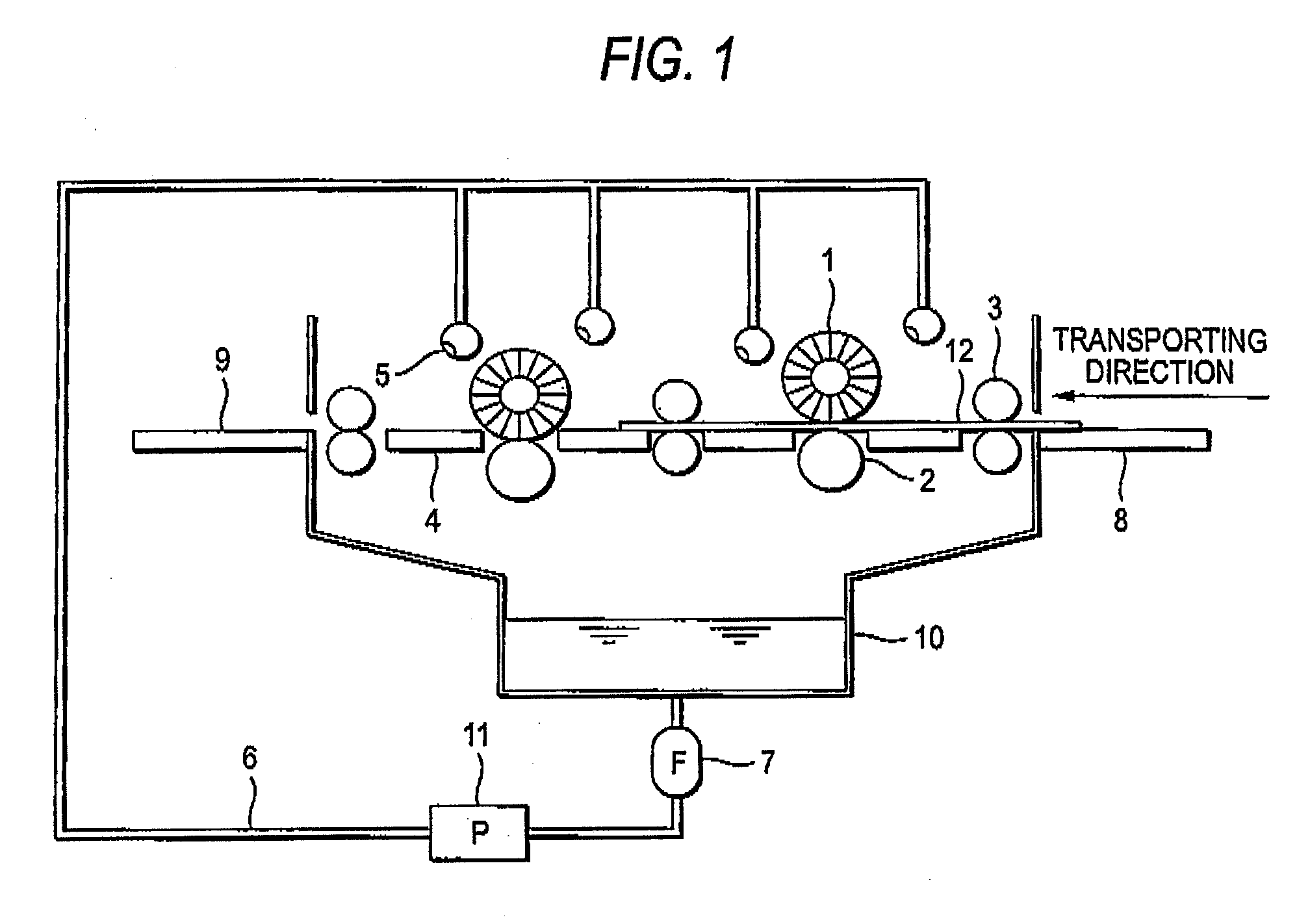Method for preparation of lithographic printing plate
a technology lithographic printing plate, which is applied in the field of preparation of lithographic printing plate, can solve the problems of poor development property and unevenness
- Summary
- Abstract
- Description
- Claims
- Application Information
AI Technical Summary
Benefits of technology
Problems solved by technology
Method used
Image
Examples
examples
[0449]The present invention will be described in more detail with reference to the following examples, but the invention should not be construed as being limited thereto.
(Components Used)
[0450](A) A solution containing 32.4% by weight of a methyl methacrylate / methacrylic acid-copolymer (weight ratio of methyl methacrylate / methacrylic acid=4:1; acid value=110 mg KOH / g) in 2-butanone (viscosity=105 mm2 / s at 25° C.)
(B) A solution containing 88.2% by weight of a reaction product of 1 mole of 2,2,4-trimethylhexamethylene diisocyanate and 2 moles of hydroxyethyl methacrylate (viscosity=3.30 mm2 / s at 25° C.)
(C) Mono Z1620, a solution containing 30.1% by weight of a reaction product of 1 mole of hexamethylene diisocyanate, 1 mole of 2-hydroxyethyl methacrylate and 0.5 moles of 2-(2-hydroxyethyl)piperidine in 2-butanone (viscosity=1.7 mm2 / s at 25° C.)
(D) 1,4-Distyryl-(3,5-trimethoxy-4-(2-butyl)oxy)benzene
(E) Heliogene blue D7490® dispersion (9.9% by weight, viscosity=7.0 mm2 / s at 25° C.), tr...
example 4
[0486]Lithographic printing plate precursor (1) was subjected to image exposure by a violet semiconductor laser plate setter Vx9600 wherein the InGaN semiconductor laser (emission: 405 nm±10 mm / output: 30 mW) was replaced with a semiconductor laser having output of 100 mW. As for the image, halftone dots of 50% were drawn using an FM screen (TAFFETA 20, produced by Fuji Film Co., Ltd.) in a plate surface exposure amount of 0.25 mJ / cm2 and at resolution of 2,438 dpi.
[0487]The exposed lithographic printing plate precursor was without performing the preheat, subjected to the development processing in the automatic development processor having a structure shown in FIG. 1 using Developer (1). The developing property and printing image-forming property were evaluated in the same manner as in Example 1 and the good results of the evaluation same as in Example 1 were obtained.
examples 9 to 22
[0489]The evaluation of developing property and printing image-forming property was conducted in the same manner as in Example 1 using each of Lithographic printing plate precursors (2) to (15). The results of the evaluation are shown in Table 14.
TABLE 14PrintingImage-formingPropertyUneven-Lithographicness ofPrintingHalftonePlateDevelopingDotPrecursorDeveloperPropertyStainImageExample 9(2)(1)◯◯◯Example 10(3)(1)◯◯◯Example 11(4)(1)◯◯ΔExample 12(5)(1)◯◯◯Example 13(6)(1)◯◯◯Example 14(7)(1)◯◯◯Example 15(8)(1)◯◯◯Example 16(9)(1)◯◯ΔExample 17(10)(1)◯◯◯Example 18(11)(1)◯◯◯Example 19(12)(1)◯◯◯Example 20(13)(1)◯◯ΔExample 21(14)(1)◯◯ΔExample 22(15)(1)◯◯Δ
PUM
 Login to View More
Login to View More Abstract
Description
Claims
Application Information
 Login to View More
Login to View More - R&D
- Intellectual Property
- Life Sciences
- Materials
- Tech Scout
- Unparalleled Data Quality
- Higher Quality Content
- 60% Fewer Hallucinations
Browse by: Latest US Patents, China's latest patents, Technical Efficacy Thesaurus, Application Domain, Technology Topic, Popular Technical Reports.
© 2025 PatSnap. All rights reserved.Legal|Privacy policy|Modern Slavery Act Transparency Statement|Sitemap|About US| Contact US: help@patsnap.com



